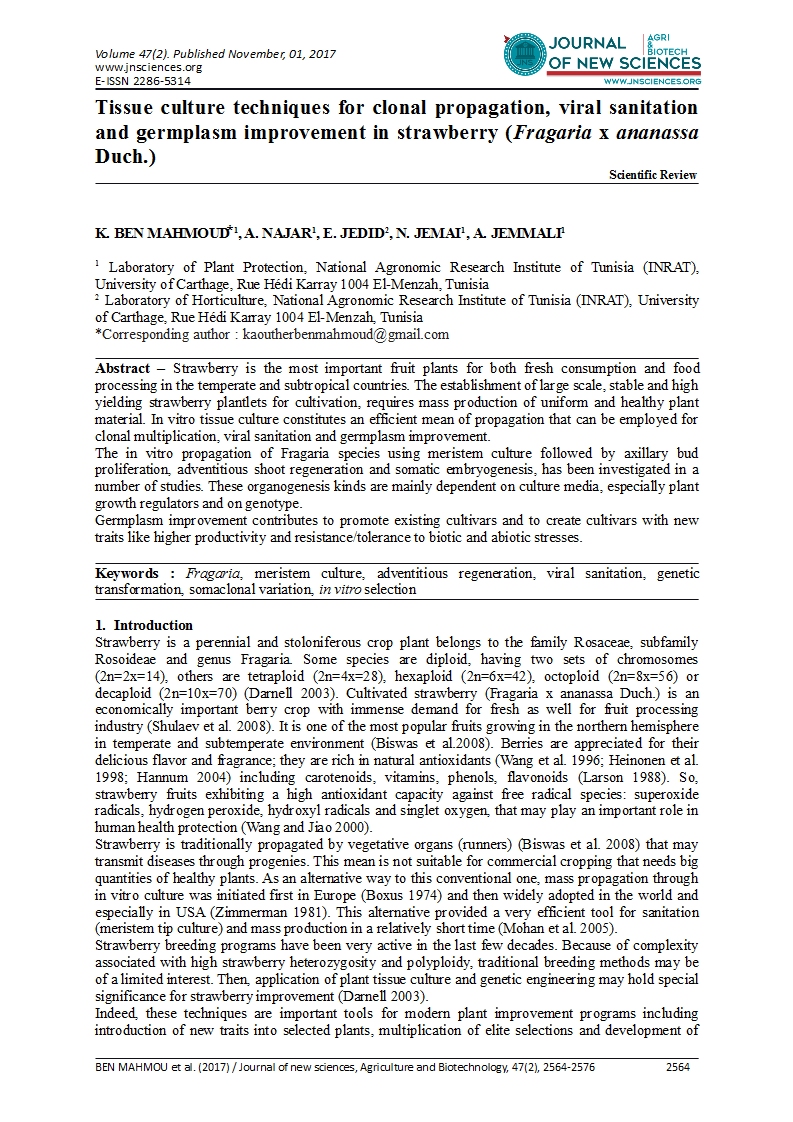Aggravation de la baisse de rentabilité de la variété d’orange (Citrus sinensis L) Maltaise demi sanguine sous l’effet d’une infection viroïdale multiple
A. NAJAR1
S. MLAOUHI2
K. BEN MAHMOUD1
A. JEMMALI1
1 Laboratoire de Protection des Plantes, Institut National de la Recherche Agronomique de Tunisie. Rue Hedi Karray, 1002 El Menzeh, Tunisie
2 Laboratoire d’Economie rurale, Institut National de la Recherche Agronomique de Tunisie. Rue Hedi Karray, 1002 El Menzeh, Tunisie
Abstract – As well as virus pathogens, viroids are able to depreciate qualitative and quantitative traits of some crop productions including citrus trees. In this regard, the present study aimed to evaluate the viroid incidence on the mean cumulative yield/tree and the gross margin (GM) of the “Maltaise demi sanguine” variety inoculated with four viroids: citrus bent leaf viroid (CBLVd), hop stunt viroid (HSVd, variant CVd-IIa), citrusdwarfing viroid (CDVd) et citrus bark cracking viroid(CBCVd).This variety has been grafted on three rootstocks (Citrange carrizo, Citrumelo swingle et Citrus volkameriana) that were previously selected to substitute sour orange who is sensitive to citrus tristeza virus. The evaluation has been realized on 10 years-aged trees that were initially inoculated under glasshouse with the above mentioned viroids separately (single infection) or mixed (co-infection with the four viroids). Main results recorded here revealed a unsignificant difference in cumulative yield for simple viroid infection whatever the rootstock used. Nevertheless, it should be interesting to mention that those viroids have been ranked: CVIIa (1), CBLVd (2), CBCVd (3) et CDVd (4) following a decreased incidence order. In the case of multiple infection, a greater decrease has been registered in dependence to the rootstock. Indeed, yield decreasing reached 19% in the case of Citrus volkamerianaand 30% in both Citrange carrizo and Citrumelo swingle. Based on the production of 2015 year, GM has consequently been more affected by multiple infections. This reductiondid not exceed 25% with Citrus volkameriana, but reached 92% with Citrumelo swingle that also more sensitivity to simple infections with CVd-IIa (41%) and CDVd (53%). These results concerning fruit yield and GM as the most important criteria, allowed to give the first place to the Citrus volkameriana rootstock either in healthy orin infected status.
Keywords : Viroïds, Rootstock, Cumulative yield , Gross margin.
Résumé – Au même titre que les virus, les viroïdes constituent des agents de dépréciation qualitative et quantitative de la production de plusieurs hôtes comme les agrumes. A ce propos, l’étude objet de cet article a porté sur l’effet d’infections viroidales sur le rendement en fruits de la maltaise greffée sur 3 porte greffes (Citrange carrizo, Citrumelo swingle et Citrus volkameriana). Ces porte-greffes ont été retenus lors d’une évaluation précédente pour substituer le bigaradier dont l'association avec les agrumes (sauf dans le cas citronnier) est sensible au virus de la Tristeza. La présente évaluation concernant le rendement moyen cumulé par pied ainsi que la marge brute (MB) générée, est faite sur des arbres âgés de 10 ans initialement inoculés sous serre par les viroïdes suivants : citrus bent leaf viroid (CBLVd), hop stunt viroid (HSVd, variant CVd-IIa), citrusdwarfing viroid (CDVd) et citrus bark cracking viroid(CBCVd) en infection simple ou mixte (co-infection par les 4 viroïdes). Les principaux résultats font état d’une influence non significative sur le rendement des différents viroïdes inoculés séparément quelque soit le porte greffe. Il ya toutefois lieu de préciser que ces viroïdes se classent comme suit suivant l’ordre décroissant de leur incidence : CVIIa (1), CBLVd (2), CBCVd (3) et CDVd (4). Dans le cas de l'infection mixte, une baisse importante des rendements cumulés est enregistrée. Elle est estimée à 19% dans le cas de Citrus volkameriana et 30% dans les deux cas de Citrange carrizoet Citrumelo swingle. La MB calculée sur la base de la production de l'année 2015, a consécutivement été plus affectée par l’infection mixte mais avec un effet porte greffe très marqué. A cet égard, alors que la MB a baissé seulement de 35% chez le Citrus volkameriana, elle a chuté de 59% avec Citrange carrizo et de 92% avec Citrumelo swingle. Ce dernier porte greffe a même montré une plus grande vulnérabilité aux deux viroïdes CVd-IIa et CDVd en infection simple. Ces résultats permettent sur la base des critères étudiés à savoir la production cumulée et la MB, de classer le porte greffe Citrus volkameriana au premier rang aussi bien à l'état sain qu’à l'état infecté.
Mots clés : Viroïdes, Porte greffe, Rendement cumulé, marge brute
Read more




